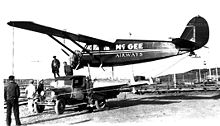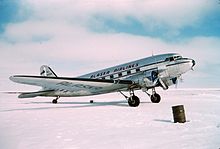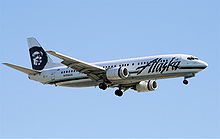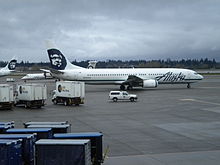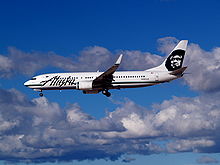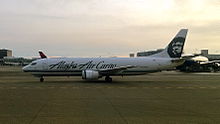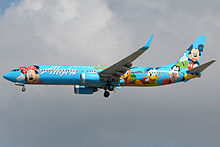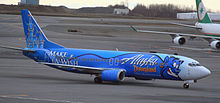- Alaska Airlines
-
Alaska Airlines 
IATA
ASICAO
ASACallsign
ALASKAFounded 1932 (as McGee Airways)[1] Commenced operations June 6, 1944[1] Hubs Secondary hubs Los Angeles International Airport Frequent-flyer program Mileage Plan Airport lounge Board Room Fleet size 117 Destinations 91 Company slogan North of Expected[2] Parent company Alaska Air Group Headquarters SeaTac, Washington Key people - William S. Ayer (CEO)
- Brad Tilden (President)
Website AlaskaAir.com 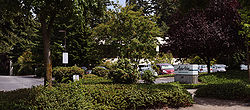 Alaska Airlines headquarters in SeaTac, Washington
Alaska Airlines headquarters in SeaTac, Washington
Alaska Airlines (NYSE: ALK) is an airline based in the Seattle suburb of SeaTac, Washington in the United States. The airline originated in 1932 as McGee Airways. After many mergers with and acquisitions of other airlines, including Star Air Service, it became known as Alaska Airlines in 1944. It has expanded greatly since its founding and now has service not only within the state of Alaska but also throughout the Continental United States, Canada, Mexico and four Hawaiian Islands. Alaska Airlines carries more passengers between the state of Alaska and the contiguous United States than any other airline.[3]
Classified as a major carrier, it is the seventh-largest US airline in terms of passenger traffic. Alaska currently operates hubs at Seattle–Tacoma International Airport, Ted Stevens Anchorage International Airport, and Portland International Airport. It also operates a secondary hub and Mexican gateway at Los Angeles International Airport.[3]
Alaska Airlines' sister carrier, Horizon Air, is closely integrated into Alaska's operations, with Alaska and Horizon sharing many routes. Both airlines are owned by the same parent company, Alaska Air Group. In 2011, J. D. Power and Associates recognized Alaska Airlines as the top "Traditional Carrier" in customer satisfaction for the fourth year in a row.[4]
The airline's frequent flyer program is called Mileage Plan, and their lounge is called Board Room. Alaska Airlines is not part of any of the three major airline alliances, but has codeshare agreements with airlines that are prominent members of Oneworld, such as American Airlines, as well as prominent SkyTeam members like Delta Air Lines.
Contents
- 1 History
- 2 Corporate affairs
- 3 Destinations
- 4 Fleet
- 5 Services
- 6 Mileage Plan
- 7 Awards and recognitions
- 8 Incidents and accidents
- 9 See also
- 10 References
- 11 External links
History
Early years (1932-1945)
See also: McGee Airways and Star Air ServiceThe airline traces its roots to McGee Airways, which was started by Linious "Mac" McGee in 1932. The airline flew its inaugural service between Anchorage and Bristol Bay with a Stinson single-engined, three-passenger aircraft.[5] In those days, there weren't any scheduled flights; a flight took place when there were passengers or a load of cargo.[6]
It was the middle of the Great Depression and the airline was always on the brink of failure. In the next few years the airline did many mergers and acquisitions that produced changes in the name and saw business expand throughout Alaska. The first of these mergers was in 1934, when McGee Airways merged with Star Air Service. With a fleet of fifteen aircraft, Star Air Service was now a dominant airline in Alaska. But Star continued to struggle financially because of high maintenance costs for its wooden planes.[7]
In 1937, Star Air Service purchased Alaska Interior Airlines[6] and was incorporated as Star Air Lines. The following year, federal regulation began when Congress created the Civil Aeronautics Board (CAB). The CAB awarded the airline most of the routes that it wanted in Alaska, but the coveted route between Seattle and Anchorage was awarded to Pan American Airways.[7]
In 1941, Star Air Service was purchased by Raymond Marshall, a businessman from New York. In 1942, the airline purchased three other airlines in Alaska, Lavery Air Service, Mirow Air Service, and Pollack Flying Service as well as a hangar at the Anchorage airport. That year, the airline's name was changed to Alaska Star Airlines.[7] The name Alaska Airlines was adopted on May 2, 1944[5] having narrowly beaten a competitor applying for the name. In the 1940s Alaska's headquarters were in Anchorage, Alaska.[8]
When the US entered World War II in December 1941, Alaska Airlines faced a shortage of pilots. Even so, Alaska Airlines purchased the Lockheed Model 18 Lodestar, its first multiengine aircraft, in 1943. Also, that year the company's stock was traded on the American Stock Exchange for the very first time. Unfortunately, the airline lacked funds and equipment, and pilots were often forced to buy fuel for their planes out of their own pockets. Presidents came and went throughout the early 1940s, too.[7]
Expansion after WWII (1945-1949)
In 1945, Alaska Airlines hired its first stewardesses. In 1947, James Wooten became president of the airline and he began to expand the airline greatly.[7] Under his leadership, the airline purchased many surplus military aircraft from the government that were used during WWII. The airline purchased Douglas DC-3s, Douglas DC-4s, and Curtiss-Wright C-46 Commandos.[5]
Worldwide charter flights
The airline used its new aircraft to expand its charter business, and by 1948, it was the world's largest charter carrier. The airline had charter flights from Anchorage to Honolulu, Hawaii as well as a flight to Chicago with a stop in Seattle. Flights on this route were technically not scheduled, but they were flown regularly.[7]
Alaska Airlines also flew in other parts of the world, and participated in airlifts such as the Berlin Airlift in Germany and Operation Magic Carpet in the Middle East. In the 1948 Berlin Airlift, the airline flew supplies to Allied West Berlin after the Soviets built the Berlin Wall around West Berlin. It also contributed to several other airlifts, including evacuating Chinese Nationalist forces during the 1949 Communist Revolution in China.[5]
Alaska Airlines played an important role in organizing an airlift of Jews from Yemen to Israel, in Operation Magic Carpet from 1949 to 1950. Alaska Airlines, along with many other airlines, helped fly Jews to Tel Aviv in the newly-created country of Israel. This was not an easy task, however. Airplanes couldn't land in Arab territory, so they had to be fitted with extra fuel tanks in order to fly nonstop between Yemen and Israel. The airplanes also had to fly over hostile territory and were often shot at by Arabs. The airport in Tel Aviv was frequently bombed, so they could not keep aircraft there overnight. There were no aircraft destroyed or lives lost.[9] The airline later played a similar role in airlifting Jews from Iraq to Israel.[citation needed]
Alaska Airlines' large charter business made it profitable, and the airline moved its base of operations to Paine Field, an airport north of Seattle. It kept a branch office in Anchorage, however. Despite its success, Alaska Airlines' worldwide charter business was short-lived. In 1949, the CAB tightened its regulations and completely shut down the airline for safety violations. The airline was also prohibited from operating worldwide charter flights, causing president James Wooten to leave the company.[7]
New leadership (1950s)
Alaska Airlines started the 1950s without its worldwide charter business and operations restricted to the state of Alaska. In 1950, it purchased two smaller Alaskan airlines, Collins Air Service and Al Jones Airways.
Though the airline had grown much under the ownership of Raymond Marshall, the CAB forced him out in 1951 due to continuing financial troubles. Also, Marshall had owned Alaska Airlines with the intent of getting money for himself, and he was not concerned about the long-term stability of the company.[7] That year also saw the CAB award Alaska Airlines with the long-coveted routes from Anchorage and Fairbanks in Alaska to Seattle and Portland in the continental United States.[6]
In 1952, the CAB appointed Nelson David as president, and he began to improve the financial stability of the airline. By 1957, with the airline in a better financial situation, David left and Charles Willis, Jr. became the airline's new president and CEO.
A pilot during WWII, Willis introduced several marketing gimmicks that set the airline apart from other airlines of the day. Under his leadership, the airline became the first to show inflight movies. The airline began service of the Douglas DC-6, the airline's first pressurized plane, enabling flights above clouds and weather disturbances. On these DC-6's, the airline introduced "Golden Nugget" service, which included an on-board saloon and piano.[7]
The jet age (1960s)
In 1960, Alaska Airlines was able to drop some routes between tiny towns in Alaska.[7]
The airline moved to the jet age when it introduced a Convair 880 in 1961.[10] The airline later introduced the Boeing 727, and that airplane became Alaska Airlines' signature aircraft for the next 25 years. It also became the first carrier to fly the Lockheed L-100 Hercules (the civil version of the C-130), which hauled oil drilling rigs to Alaska's North Slope and later to Ecuador.[6]
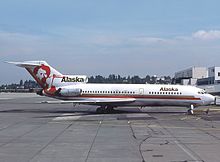 A Boeing 727-100 at Seattle-Tacoma International Airport. The airline introduced this type in the mid-1960s.
A Boeing 727-100 at Seattle-Tacoma International Airport. The airline introduced this type in the mid-1960s.
During this time, Alaska Air faced some tough competition with other airlines such as Pan Am, Northwest Airlines and a regional carrier called Pacific Northern Airlines (later merged with Western Airlines). To set itself apart from the competition, it turned to some cheap but imaginative gimmicks such as having safety instructions read as rhymes, fashion shows in the aisles, as well as bingo games.[7]
In the early 1960s Alaska Airlines had its headquarters in what is now the Belltown area of Seattle.[11] Alaska also owned two Lockheed L-1649A Starliners from 1962 to 1968, which were used for Military Air Transport Service operations.[12][13][14]
In December 1962 Air Guinée signed a contract with Alaska Airlines which saw Alaska Airlines providing management expertise, in addition to two Douglas DC-6s. The deal would have seen Alaska Airlines contracting with the airline over a seven-year period; however, the contract ended after only six months, leading to the United States Agency for International Development paying a US$700,000 debt owed by the Guinean airline to Alaska Airlines.[15]
Throughout the 1960s, Alaska Airlines worked to promote tourism to Alaska by offering charter flights to the continental United States. In an attempt to increase the state's appeal, Alaska Airlines conducted a promotional tour of Japan in 1963.
In 1967, as the state of Alaska celebrated its centennial, Alaska Airlines introduced a promotional "Gay Nineties" theme with stewardesses dressed in Edwardian outfits. That year, Alaska Airlines expanded to southeast Alaska with the introduction of service to Sitka, Alaska. This led to the purchase of two smaller airlines—Alaska Coastal Ellis and Cordova Airlines—in 1968.[7]
Economic hardship (1970s)
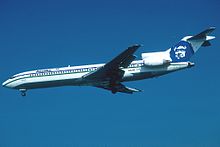 A Boeing 727-200Adv on approach to Los Angeles International Airport, showing the new livery and logo introduced in the early-1970s.
A Boeing 727-200Adv on approach to Los Angeles International Airport, showing the new livery and logo introduced in the early-1970s.
In the beginning of the 1970s, Alaska Airlines began charter service to Siberia in the Soviet Union. The airline was able to fly more than two-dozen flights in 1970, 1971, and 1972.[7]
However, the airline was not in good financial shape at that time. Like much of the airline industry, Alaska Airlines was hit with rising fuel and operating costs that nearly caused the airline to go bankrupt.[5] Also, work on the Trans-Alaska Pipeline System was delayed, and cargo planes sat idle and decreased revenues. The airline took another blow on September 4, 1971, when a plane crashed on landing in Juneau, killing 111 people and resulting in the worst single-plane crash at the time.
Because the airline was struggling financially, the airline's board ousted the president and CEO Charles Willis. Former board member Ronald Cosgrave succeeded him. The airline was $22 million in debt when Cosgrave took over, so Cosgrave began to make major cuts. The airline's cargo business was dropped completely, as well as many flights and employees. Cosgrave also sought to improve the airline's tarnished image of "Elastic Airlines." The logo was changed to an image of a smiling Eskimo, which remains today. As a result of these efforts, the airline made a profit in 1973 and continued to be profitable thereafter.[7]
Post-deregulation expansion (1978-1990)
Alaska Airlines was one of only three US carriers that supported the 1978 Airline Deregulation Act, knowing that they would reap significant growth and other benefits from deregulation.[6] After deregulation, the company's real-estate division was spun off into its own company, with Cosgrave becoming its chairman. Leadership of the airline was passed to Bruce Kennedy, a close associate of Cosgrave. Cosgrave made an alliance with Alaska Airlines to purchase competitor Wien Air Alaska, but this ultimately failed and resulted in fines for Alaska Air and its leaders for improprieties during the attempted acquisition.[7]
At the time of deregulation, Alaska Airlines served ten cities in Alaska and one in the continental US, the city of Seattle and it had only ten planes in its fleet.[6] Immediately after deregulation, the airline began to expand. The airline added the cities Portland, Oregon and San Francisco, California to its routes. Soon later, the airline resumed service to the Alaskan cities Nome and Kotzebue and also introduced service to Palm Springs, California. The cities Burbank and Ontario, California were added in 1981.[6][7] Other cities in the continental US that were added to the airline's route map by 1985 were Oakland and San Jose, California; Spokane, Washington; Boise, Idaho; Phoenix, Arizona and Tucson, Arizona.[6]
Deregulation also brought challenges to the airline, however. The airline was faced with increased competition and inflation that put tremendous pressure on costs, profits, and salaries. There were also tensions with unions, particularly mechanics and flight attendants.[5] In 1985, the company had a three month long strike with its machinists. By June, it was able to end the strike by promising to reduce labor costs and maintain peace with unions.
In November 1985, the airline introduced a daily air-freight service called "Gold Streak." With service to and from Alaska, it turned out to be quite popular.[7]
In 1985, Alaska Air Group was formed as a holding company for Alaska Airlines. In 1986 Alaska Air Group acquired regional airline Horizon Air. Horizon Air remained a separate brand from Alaska Airlines; it and Alaska Airlines are both subsidiaries of Alaska Air Group. In 1987 Alaska Airlines purchased Jet America Airlines.[10][16]
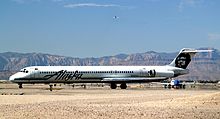 Alaska Airlines was the launch customer for the MD-83 and operated many of these jets throughout the 1980s and 1990s.
Alaska Airlines was the launch customer for the MD-83 and operated many of these jets throughout the 1980s and 1990s.
In the 1980s, Alaska Airlines began acquiring McDonnell Douglas MD-80s to replace their aging 727s. Alaska's MD-82s entered the fleet via the acquisition of Jet America Airlines in 1987. However, Alaska was also the launch customer for the MD-83, and took delivery of the first airplanes in 1985.
There was also a big seasonal imbalance in travel to Alaska, which mainly took place in the summer. In an effort to compensate for this, the airline introduced service to Mexican resorts, where most travel takes place in the winter. In 1988, the airline began service to the Mexican resort cities of Mazatlan and Puerto Vallarta.[7]
By the end of the 1980s, 70 percent of Alaska Airlines' passengers flew south of Seattle and the airline served 30 cities in six states outside Alaska. The airline had successfully used the state of Alaska as a springboard to expand into larger, more profitable markets. And the airline remained committed to quality customer service, focusing on providing better food and more leg room on flights than any other airline.[7]
New competition, new technologies (1990s)
The airline began the 1990s with plans to lease 24 Boeing 737-400s from International Lease Finance Corporation (ILFC). The airplanes remain in Alaska's fleet to this day.
In 1991, Alaska Airlines added several routes. In the Russian Far East, it added the cities Magadan and Khabarovsk, as well as service to Toronto, its first Canadian city and the first city east of the Rocky Mountains. However, Toronto was later dropped in 1992.
As the airline marked its 19th consecutive year of profits in a turbulent industry and racked up many awards for customer service, Bruce Kennedy retired in May 1991 and was succeeded by Raymond J. Vecci.
However, Alaska Airlines also faced increased competition from low-cost carriers. One carrier that competed with Alaska was MarkAir. Since it began operating in 1984, competition had been reduced because it had worked out feeder agreements with Alaska Airlines. However, after Alaska Air declined to buy the airline in the fall of 1991, it unleashed intense competition on the airline. The airline offered low-cost service on the Anchorage-Seattle route and other routes in Alaska, where Alaska Airlines earned almost one-third of its revenues.
This really hurt Alaska Airlines; for the first time in 20 years, it posted a loss of $121 million. To save money, the airline canceled two proposed maintenance facilities and deferred a large aircraft purchase worth $2 billion. It was able to increase utilization on its existing planes, though. The airline also cut labor costs, but this ended up making relations with unions tense.
These cost reductions produced quick results. In 1993, their losses decreased to $45 million, and they made a $40 million profit the next year. Eight percent of these revenues were generated by record-setting cargo operations.[7]
Alaska had more competition in 1993 when low-cost airline Southwest Airlines entered the Pacific Northwest by purchasing Morris Air. Nevertheless, Alaska airlines was able to keep its costs down, but it maintained its high level of customer service. The airline also promoted itself as "the last great airline"[7] and with the motto "For the same price, you just get more,"[6] yet analysts felt that Alaska Air needed deeper cost cuts. At the same time, the company had many strikes by the flight attendants' union.[7]
Alaska continued to take delivery of new MD-83s during the 1990s,[citation needed] both to meet the demands of a growing route system, and to replace its aging and fuel inefficient 727 fleet. Meanwhile, the airline phased out its 727s, retiring their last 727 in 1993.[citation needed] The airline's MD-80 fleet peaked at approximately 45 aircraft in 1996.[citation needed]
Vecci was dismissed in 1995 and replaced with John Kelly, former Horizon Air CEO. The airline soon expanded West Coast routes to take advantage of an "open skies" agreement between the US and Canada. The airline also added a new destination in Russia.[7]
Alaska Airlines also pioneered some new technologies through the 1990s. It added a head-up guidance system in 1989 to operate better in foggy conditions, becoming the first airline to use this technology. In 1995, the airline became the first to sell tickets on the Internet. The airline also installed self-service kiosks called "Instant Travel Machines" that printed boarding passes, allowing customers to bypass the traditional ticket counter. An X-ray device, an addition to the unit allowing passengers to check their own baggage was being tested in 1999 at Anchorage. By 2000, all the airline's planes carried automated external defibrillators, for use in in-flight emergencies.[7]
The airline would also become the first airline in the world to integrate GPS and Enhanced Ground Proximity Warning System (EGPWS) technology, adding a real-time, three-dimensional display of terrain. The system was operational in all the carrier's Boeing 737-400s by April 1999.[7]
The late 1990s also saw the airline recording much profitability. The airline added new training and maintenance facilities. Also, the airline began buying new 737s,[7] ordering the Boeing 737-700 and the Boeing 737-900. Alaska Airlines became the launch customer for the 737-900 when it placed an order for it in 1997.
Introducing flights across the USA (2000s)
An Alaska Airlines Boeing 737-900 at Seattle-Tacoma International Airport. Alaska was the launch customer of the 737-900 aircraft.
On May 15, 2001, the airline took delivery of its first 737-900. Currently, the airline has 12 of these aircraft.
With the delivery of Boeing 737 Next Generation aircraft starting in 1999, Alaska began launching more long-haul flights. In 2000, Alaska started service between Anchorage and Chicago. In 2001, the airline was granted slot exemptions by the Department of Transportation to operate a nonstop flight from Ronald Reagan Washington National Airport (DCA) to Seattle, but it was halted after only a week due to the September 11, 2001 attacks. Service to Washington, DC was relocated to nearby Dulles International Airport, but the airline resumed service to Reagan Airport on December 4, 2001 to meet the demand. It continued service to Dulles Airport, however.[17] In 2004 Alaska Airlines introduced non-stop service between Reagan National and Los Angeles.
In 2002, other long-haul flights from Seattle were launched, including flights to Orlando[18] and Miami, Florida,[19] as well as service to Newark, New Jersey.[20] In 2003, service to Boston began,[21] as well as service to Dallas.
In 2005, due to the greater efficiency of the Boeing 737 Next Generation and rising costs for maintenance, fuel, and crew training, Alaska Airlines decided to phase out its remaining 26 MD-80s and trained its pilots to fly the newer Boeing 737-800s that were being ordered to replace them. According to the airline, the MD-80 burned 1,100 gallons of fuel per hour, while the 737-800 burns 850 gallons per hour. The last MD-80 flights flew on August 25, 2008, one flight from San Jose, California to Seattle, Washington, and another from Sacramento, California to Seattle, Washington.[22] To mark this occasion, the airline unveiled a 737-800 painted in Boeing's house colors with the airline's Eskimo on the tail fin. The aircraft, called Spirit of Seattle, shows Alaska's commitment to Boeing and the fact that the airline now has an all-Boeing fleet.[23]
In February 2007, Alaska Airlines introduced its first two Boeing 737-400 Combi's to their fleet in an effort to replace their aging Boeing 737-200 Combi aircraft. The -400 Combi's have 20% more passenger and cargo capacity than the aircraft they replaced. They can carry a combination of four cargo pallets and 72 passengers. The aircraft were originally introduced as passenger aircraft in 1992, but have now been converted by Pemco Air Services. Pemco Air Services also converted the Boeing 737-400F. The airline planned to introduce more combi aircraft towards the end of the year.[24]
On September 9, 2007, Alaska Airlines introduced daily nonstop service between Portland, Oregon and Orlando, Florida and from Portland, Oregon to Boston, Massachusetts.[25]
In late 2007, the airline began service to Hawaii. When the airline first began seasonal service to Hawaii, it flew to Honolulu, Hawaii from Seattle and Anchorage. It would later expand service over the next few years to include Hawaiian cities Lihue, Kahului, and Kona, with service from Portland, Oregon; Sacramento, California; Oakland, California[26] and even Bellingham, Washington.
In 2008, Alaska launched service from Seattle to Minneapolis – Saint Paul and in 2009 began service to Austin, Texas. Service from Seattle to Houston began on September 23, 2009 and from Seattle to Atlanta on October 23, 2009.[27]
On November 10, 2009 Alaska Airlines announced that it would begin service between San Jose, CA and Kahului and Kona, Hawaii in March 2010. On March 26, 2010 Alaska began service between Sacramento, CA and Kahului, HI.[28] These latter non-stop additions, for which neither Oakland, Sacramento, Kona, or Kahului, are hubs or focus cities of Alaska, is a rarity in today's commercial airline industry where the tendency is for an airline to concentrate its flights around some sort of "hub and spoke" route system.
2010s
On June 17, 2010 Alaska Airlines announced that it would begin new service between Seattle and Lambert-St. Louis International Airport. Service began on September 27, 2010.[29]
In January 2011, Alaska Airlines placed an order for 15 737s, worth $1.3 billion in list prices. The order consists of two 737-800s and thirteen 737-900ERs (Extended Range). The 737-900ERs are a new addition to Alaska Airlines' fleet, and will be used on the airline's long-haul routes.[30]
Thanks to its increased range, the 737-900ER will be able to fly transcontinental routes with more passengers, such as the Seattle-Orlando route. “Depending on the ultimate configuration, the larger 737-900ER will have between 21 and 27 seats more than our existing B737-800 aircraft and will be a perfect fit for our longer-haul and high-traffic West Coast markets,” Alaska Airlines President Brad Tilden said in his company’s release. The planes will be delivered between 2012 and 2014.[31]
The airline also recorded record profits for 2010, as well as record profits for the fourth quarter of 2010. The profit for 2010 was $251.1 million, up from $121.6 million a year earlier. Alaska’s fourth-quarter profit of $64.8 million was up from $24.1 million from the fourth quarter of the previous year.[31]
Alaska Airlines continues pioneering new technologies today. In 2011 Alaska Airlines partnered with Boeing and Fujitsu to be the first to use a new technology called Component Management Optimization, which will streamline maintenance checks. It will do this by allowing mechanics to point a handheld device at little RFID tags attached to certain parts of the aircraft, which will display information about when parts were last replaced. This will allow mechanics to perform inspections quicker than conventional methods. The program is scheduled to launch in 2012.[32] Also in mid-2011, the airline issued iPads to its pilots to replace 25 pounds of paper flight manuals that pilots are currently required to carry on flights. Alaska is the first major airline to use iPads on flights; all pilots had iPads by mid-June. This is the first part of the airline's initiative to do away with the flight bag; the airline is also considering using iPads for displaying aeronautical charts.[33]
Alaska Airlines launched a Facebook app called FlyingSocial in late 2011. FlyingSocial lets its users share Alaska’s fare deals and discounts with their Facebook friends. Once you sign up for the app, the software takes a few seconds to hunt down all your friends on Facebook, and then pulls up a map with their profile pics, locations and any special deals involving that destination.[34]
Since November 9, 2011 Alaska Airlines has flown 2 (expected to be 75) commercial passenger flights in the U.S. powered by biofuel using a 20 percent blend of sustainable biofuel made from used cooking oil that meets rigorous international safety and sustainability standards.[35]
Corporate affairs
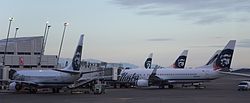 Alaska Airlines operations at Seattle-Tacoma International Airport.
Alaska Airlines operations at Seattle-Tacoma International Airport.
Employees
As of June 2011, Alaska Airlines employs 9,617 employees.[3] Alaska's pilot group consists of approximately 1300 pilots represented by the Air Line Pilots Association, International.[citation needed]
Alaska Airlines Foundation
The Alaska Airlines Foundation, headquartered on the grounds of Ted Stevens International Airport in Anchorage, Alaska, gives grants to 501(c)(3) non-profit organizations that are classified as charities in the U.S. states of Alaska and Washington.[36]
Alaska Air Cargo
Alaska Air Cargo has regional operations in parts of the United States. It flies the Boeing 737 (400/700/800/900). It operates one B737-400F (freighter) and five B737-400C (combi). Alaska's cargo operations are focused primarily on the northwestern contiguous states and Alaska.
Destinations
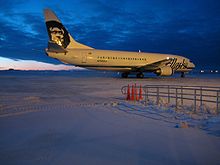 An Alaska Airlines Boeing 737-400 Combi at Wiley Post–Will Rogers Memorial Airport in Barrow, Alaska.
An Alaska Airlines Boeing 737-400 Combi at Wiley Post–Will Rogers Memorial Airport in Barrow, Alaska. Main article: Alaska Airlines destinations
Main article: Alaska Airlines destinationsAlaska's route system spans more than 92 cities in the United States, Canada, and Mexico. Some of the locations served in the carrier's namesake state include Prudhoe Bay, Anchorage, Adak, Cordova, Juneau, Kodiak, Kotzebue, King Salmon, Nome and Sitka, several of which are inaccessible by road. During the 1980s Alaska Airlines operated a unique interchange of aircraft and aircrews to Texas with first, Braniff International and subsequently American Airlines, after the demise of Braniff in 1982.[citation needed] The airline began scheduled operations to the Russian Far East in 1991 following the breakup of the Soviet Union, but suspended the service in 1998 following the 1998 Russian financial crisis. The airline flew MD-80 aircraft on these routes.[37]
Alaska has historically been one of the largest carriers on the US west coast as well as to and within the state of Alaska, with strong presences in Seattle, Portland, the San Francisco Bay Area and the Los Angeles Metro Area (serving all five LA-area and four Bay Area major airports). With the delivery of 737 Next-Generation aircraft starting in 1999, Alaska began launching more long-haul flights across the USA. Now, the airline operates many such flights.
In February 2011, Alaska Airlines announced an agreement under which SkyWest Airlines would begin operating six of its West Coast routes starting in May 2011. They are operating five CRJ-700s purchased from Horizon Air under a capacity purchase agreement. This means that SkyWest would own and operate the aircraft, while Alaska Airlines would be responsible for marketing and selling tickets for the flights. The CRJ-700s are operating on routes that would not be feasible to operate with neither Bombardier Q400s nor Boeing 737s.[38]
Alaska Airlines does not participate in any major global airline alliances, but the airline has codeshare agreements with several airlines.[39] However, many of these airlines are members of global airline alliances.
- Air France (SkyTeam)
- Air Pacific
- American Airlines (Oneworld)
- British Airways (Oneworld)
- Cathay Pacific (Oneworld)
- Delta Air Lines (SkyTeam)
- Era Alaska
- Garuda Indonesia (future SkyTeam member)
Since 2008, Alaska Airlines flights, as well as Horizon Air flights, have been part of oneworld Global Explorer fares.[40]
Fleet
Current fleet
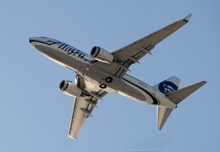 Alaska Airlines Boeing 737-700 departs San Diego's Lindbergh Field
Alaska Airlines Boeing 737-700 departs San Diego's Lindbergh Field
With the exception of Bombardier CRJ700s operated by SkyWest Airlines, Alaska Airlines has an all-Boeing 737 fleet with an average age of 8 years. As of June 2011, it consists of the following aircraft:[41]
Alaska Airlines fleet Aircraft In service Orders Passengers Notes P Y Total Boeing 737-400 24 — 12 132 144 Boeing 737-400C 5 — — 72 72 Freight capacity of 4 freight pallets[42] Boeing 737-400F 1 — Cargo Freight capacity of 9.5 freight pallets[43] Boeing 737-700 17 — 12 112 124 Boeing 737-800 58 10 16 141 157 Boeing 737-900 12 — 16 156 172 Launch customer Boeing 737-900ER[30][31][44] — 13 16 156 172 Total 117 23 - Fleet Notes
Since the retirement of its MD-80s in 2008, Alaska Airlines has been operating a fleet consisting of only Boeing 737s. Alaska Airlines became the launch customer of the Boeing 737-900 in 1997 and currently operates twelve of the aircraft. All of its 737-700s, -800s, -900ERs, have blended winglets, as well as 9 of its 12 737-900s.
Fleet Plans
In January 2011, Alaska Airlines placed an order for thirteen 737-900ERs in January 2011. The aircraft will be delivered between 2012 and 2014.[30][31][44] The "ER" stands for "Extended Range."
In 2012, Alaska Airlines will retire 3 of its 737-400s, but will introduce six Boeing 737-800s into service that same year.[41]
Fleet history
-
This list is incomplete; you can help by expanding it.
Alaska Airlines Retired Fleet Aircraft Introduced Retired Replacement/ Notes Stinson (various models) 1932 19?? McGee Airways operated various Stinson aircraft Lockheed Model 18 Lodestar 1943 19?? First Twin-engine aircraft Douglas DC-3 1945 1953 Purchased from the US Army Air Force after WWII Douglas DC-4 1946 1963 Purchased from the US Army Air Force after WWII Curtiss-Wright C-46 Commando 1948 1961 Purchased from the US Army Air Force after WWII Douglas DC-6B 1961 1963 Convair 880 1961 1966 First jet aircraft; replaced with Boeing 727-100 Convair 340 1962 1965 Lockheed L-1649A 1962 1968 used for MATS operations Lockheed L-1049H 1964 1967 Lockheed L-100 Hercules 1965[45] 1971 Boeing 727-100 1966[46] 1985 Replaced with McDonnell Douglas MD-83 Convair 990 1967 1968 Convair 240 1968 1969 Acquired with purchase of Alaska Coastal Airlines and Cordova Airlines; replaced with Twin Otter Grumman G-21 Goose 1968 1972 Acquired with purchase of Alaska Coastal Airlines de Havilland Canada DHC-6 Twin Otter 1969 1976 Boeing 720[47] 1972 1975 Ex-United Airlines aircraft Boeing 727-200 1978 1993 Replaced with McDonnell Douglas MD-83 Boeing 737-200 Quick Change 1985 2007 Replaced with Boeing 737-400F and 737-400C McDonnell Douglas MD-82 1987 2006 Acquired with purchase of Jet America Airlines; replaced with Boeing 737-800 McDonnell Douglas MD-83 1985 2008 Launch customer; Replaced with Boeing 737-800 Ever since the 1960s, Alaska has been using Boeing aircraft for its fleet. Besides the current 737s Alaska has used, Alaska had operated the Boeing 727. Alaska had used the 727s largely during the building of the Alaska oil pipeline in the 1970s to haul equipment and passengers up to the North. The last 727 was retired in 1993.[citation needed]
In the 1980s, Alaska began acquiring McDonnell Douglas MD-80s. Alaska's MD-82s entered the fleet via the acquisition of Jet America Airlines in 1987. However, Alaska was also the launch customer for the MD-83, and took delivery of the first airplanes in 1985.[citation needed] Alaska continued to take delivery of new MD-83s during the 1990s,[citation needed] both to meet the demands of a growing route system, and to retire its aging and fuel inefficient 727 fleet. The MD-80 fleet peaked at approximately 45 aircraft in 1996.[citation needed] In 2005, due to the greater efficiency of the Boeing 737 Next Generation and rising costs for maintenance, fuel, and crew training, Alaska Airlines decided to phase out the remaining 26 MD-80s and trained the pilots to fly the newer 737-800s that were being ordered to replace them. The last MD-80 flights flew on August 25, 2008, one flight from San Jose, California to Seattle, Washington, and another from Sacramento, California to Seattle, Washington.[citation needed]
Alaska also used eight Boeing 737-200 Combi/QCs to suit the unique needs of flying in the state of Alaska. These aircraft were valued for their ability to be rapidly reconfigured (hence the moniker QC or "Quick Change") to match the specific cargo and passenger loads for any given flight.[48] In the all-freight configuration, the 737-200 Combis carried up to 6 cargo containers, known as "igloos." The palletized floor allowed for passenger seating to range from 26 with 5 cargo pallets to 111 in the all-passenger configuration. The 737-200s were also gravel-kitted, which allowed them to be used at airports such as Red Dog, Alaska (RDB), which formerly featured a gravel runway. Due to their fuel inefficiency and rising maintenance costs, Alaska decided to phase-out the 737-200s between 2005 and 2007, replacing them with six reconfigured 737-400s. Five feature a cargo/passenger arrangement, and one is a "freighter" carrying only cargo. Unlike the 737-200 Combi, the 737-400 Combis feature a fixed seating capacity of 72 seats. The last 737-200 Combi (short for combination) was retired in 2007 and is now displayed at the Alaska Aviation Heritage Museum.[49][dead link]
Livery
 Boeing 737-400 (N792AS) in "Salmon Thirty Salmon" colors;[50] taken at Seattle–Tacoma International Airport. (2008)
Boeing 737-400 (N792AS) in "Salmon Thirty Salmon" colors;[50] taken at Seattle–Tacoma International Airport. (2008)
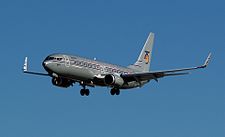 The Starliner 75th Anniversary scheme on a 737-800. (2007)
The Starliner 75th Anniversary scheme on a 737-800. (2007)
Alaska's first livery consisted of the words "Alaska" in gold on its tails. During the early 1970s, a painting of a native Alaskan, still used by the carrier today, was added to the livery. There are numerous anecdotes linking the Eskimo face wearing a parka to different celebrities, including once to Chester Seveck by an Alaskan senator.[51] In 1988, the airline hired a design firm and planned to replace the native face with a new logo, featuring a stylized image of a mountain, citing customer confusion with the original logo among its other markets in California and Southwestern United States. The plan was ultimately withdrawn after many Alaskans became upset with the idea of abandoning the original Eskimo design.[51]
Today most of its aircraft are white with a blue and teal stripe running the length of the left and right sides of the fuselage, with "Alaska" in the company's present-day wordmark displayed prominently on the sides, and the native Alaskan portrait on the vertical stabilizer.[52] The carrier also has several special liveries:
- Two aircraft feature special Disney paint schemes, all of which promote vacations to the Disneyland Resort:
- One 737-900 (registration number N318AS) is dubbed the "Spirit of Disneyland II," prominently featuring Mickey Mouse and other classic Disney characters. This aircraft replaced the original "Spirit of Disneyland" 737-400 retired at the end of November 2009.[52]
- "Magic of Disneyland," a Boeing 737-400, features Tinkerbell and was painted to promote the Disneyland Resort's 50th Anniversary.[52]
- "Spirit of Make-A-Wish" is a cross-promotion with the Make-a-Wish Foundation. It features the Genie from the Disney film Aladdin[52] and was painted to promote the Resort's Year of a Million Dreams promotion. Its registration number is N706AS.
- One 737-400 registration number N792AS is painted to look like a giant salmon, and is known in aviation circles as the "Salmon-Thirty-Salmon".[52]
- One 737-400 has been converted to a full freighter and features Alaska Air Cargo titles.[52]
- One 737-800 N548AS features a "reverse color scheme" livery with alaskaair.com painted on the sides.[52]
- One 737-800 N569AS, dubbed "Starliner 75", features Alaska's first color scheme, painted to celebrate the carrier's 75th anniversary. The aircraft features the carrier's 75th anniversary logo on the vertical stabilizer, as well as a Boeing logo from the same period on the fuselage below the flight deck windows.[52]
- Nineteen 737-800s feature a native Alaskan on the vertical stabilizer wearing a Hawaiian lei to indicate aircraft certified to fly to Hawaii.[citation needed]
- One 737-800 N512AS, dubbed "Spirit of Seattle," is a hybrid of two companies' liveries, with the fuselage painted in Boeing's corporate livery, the "Alaska" wordmark near the aft end of the fuselage, and native Alaskan from Alaska's livery on the vertical stabilizer.[52] This aircraft was painted to commemorate Alaska's conversion to an all-Boeing fleet, as well as the Seattle roots of both companies (Boeing was founded in Seattle and still accomplishes final assembly for all its commercial aircraft in the Seattle area).
- One 737-400 N705AS, features a musher and sled dog, state ferry, Native Alaskan canoe, bear and whale, along with the statement, "We're all pulling together" to celebrate 50 years of Alaska statehood. The unique design dubbed "The Spirit of Alaska Statehood" was created by 16-year-old Sitka student Hannah Hamberg.[53]
- The newest special livery is the Timbers Jet, which features the colors and logo of the Portland Timbers soccer team on a Boeing 737-700.[52]
- One 737-800 featured Apolo Ohno, encouraging people to support him at the 2010 Winter Olympics.[citation needed]
Services
On-board meals
Complimentary meals or light snacks are served to passengers in the first class cabin. In 2006 the airline launched its buy on board meal program, known as Northern Bites, on most flights over three hours, including all transcontinental flights.[54] As part of the buy on board program, the airline offers various "Picnic Packs" for a charge in coach class on all flights.
On-board entertainment
Alaska Airlines is recognized by the World Airline Entertainment Association (WAEA) as having an "historic first" in Inflight entertainment by introducing in October 2003 the first portable, hard-drive based, audio-video-on-demand (AVOD) players that deliver a variety of film, TV, and audio programs.[55] The device, called the digEplayer was conceived and brought to market by an Alaska Airlines baggage handler named Bill Boyer Jr.[56][57]
Alaska Airlines received the "Airline IFE Service of the Year" award at the March 2004 IPEC/LARA Inflight Online Awards Dinner based upon the implementation of the digEplayer, which was awarded "IFE Product of the Year."[58]
digEplayers are available for rent on most long-haul flights for a fee, although they are complimentary to passengers seated in First Class.[59]
On-board internet access
Alaska launched trials of in-flight In-flight Wi-Fi internet service in 2009.[60][61]
On April 24, 2010 Alaska decided on offering the AirCell Gogo[62] land-based Internet Service for all its planes after it finishes testing it on a 737-800. It was initially testing the competing Row44 satellite-based system.[63] Service is now available on flights between Anchorage and Fairbanks.[64]
As of November 2011, almost all of its aircraft feature Wi-Fi internet access during flights. There are only nine aircraft without Wi-Fi, those being its three of its 737-400s as well as the 737-400 freighter and combi aircraft.[65][66]
This service is fee-based for all passengers, depending on the length of the flight.
Lounge
Board Room is the Alaska Air Group airport lounge, and are located in five west coast airports: Anchorage, Los Angeles, Portland, San Francisco, and Seattle. Board Room Members also have access to Delta Air Lines Sky Club at airports across the country,[67] and Delta Air Lines' Sky Club members have access to Alaska Airlines's Board Room lounges.[68] Memberships start at $45 for a single-day pass, up to $875 for a new three-year membership. MVP members receive a 50% discount on the initiation fee and MVP Gold members have their initiation fee waived. Both MVP and MVP Gold are still responsible for the actual annual membership fee.[69][70]
Mileage Plan

Mileage Plan is the frequent-flyer program of the Alaska Air Group, Alaska Airlines and Horizon Air. The program's airline partners also include Oneworld member airlines American Airlines, British Airways, Cathay Pacific, LAN, and Qantas; SkyTeam member airlines Air France, and Delta Air Lines; as well as Air Pacific, Era Aviation, Frontier Alaska, Icelandair, Kenmore Air, Mokulele Airlines, and PenAir.[71]
The Mileage Plan program has no membership fee, and accumulated miles never expire. However, if a Mileage Plan member does not accumulate mileage within nine months of becoming a member, or a member's account remains inactive with zero miles earned or spent for a consecutive 24 month period, Alaska reserves the right to cancel the account and dissolve any unused miles. Cancelled accounts can be reinstated within one year of their deletion for a $75 fee.[72]
MVP, MVP Gold and MVP Gold 75K are Mileage Plan's elite tiers for frequent travelers.[73] Higher-tiered members are provided with increased travel benefits such as bonus mileage, priority boarding and complimentary upgrades to first class.[69] Delta and Alaska Airlines offer reciprocal benefits; SkyMiles members who are Gold, Platinum, or Diamond Medallion, as well as Alaska Airlines Mileage Plan MVP Gold and MVP Gold 75K members, have reciprocity in priority boarding, check-in, seat assignment, and upgrade benefits. Delta Silver Medallion and Alaska Airlines MVP members have a reduced level of reciprocal benefits. Reciprocal elite benefits are not available for other airline partners.[68]
- MVP is achieved or retained when the member flies 20,000 miles (32,000 km) on Alaska Airlines or Horizon Air, 25,000 miles (40,000 km) on Alaska Airlines, Horizon Air, American Airlines, Delta Air Lines, KLM, Air France, or LAN, or 30 one-way segments on any combination of Mileage Plan members in a single calendar year. Membership benefits include 50 percent bonus mileage, priority check-in at First Class counters, priority seating on board Alaska Airlines and Horizon Air flights, as well as a 50 percent discount on Board Room membership. Members booked in fare class Y and YAS, also known as Full Flex fares, can be upgraded to First Class at any time, and all other fare categories with in 48 hours of flight.[69]
- MVP Gold is achieved or retained when the member flies 40,000 miles (64,000 km) on Alaska Airlines or Horizon Air, 50,000 miles (80,000 km) on Alaska Airlines, Horizon Air, American Airlines, Delta Air Lines, KLM, Air France, or LAN, or 60 one-way segments on any combination of Mileage Plan members in a single calendar year. Membership benefits include 100 percent bonus mileage, priority check-in at First Class counters, priority security at select airports, and priority seating on board Alaska Airlines and Horizon Air flights. Members booked in fare class Y, S, B, M, H, also known as Value and Full Flex fares, can be upgraded to First Class at any time, and all other rate categories within 72 hours of flight. Companions also receive this benefit, and members are given four complimentary upgrade certificates for guests annually.[69]
- MVP Gold 75K is achieved or retained when the member flies 75,000 miles (121,000 km) on Alaska Airlines or Horizon Air, 90,000 miles (140,000 km) on Alaska Airlines, Horizon Air, American Airlines, Delta Air Lines, KLM, Air France, or LAN, or 90 one-way segments on any combination of Mileage Plan members in a single calendar year. Membership benefits include top priority on the First Class waitlist when purchasing a qualifying fare in fare class Y, S, B, M, H, also known as Value and Full Flex fares, the ability to upgrade five days before departure when purchasing a non-qualifying fare, opportunity to nominate a friend or family member to MVP Status, 50,000 bonus miles when attaining the MVP Gold 75K level, dedicated MVP Gold 75K customer care and reservations phone lines, complimentary DigEplayer when flying in the main cabin, discounted Board Room Membership plus four complimentary day passes, 100 percent bonus mileage, priority check-in at First Class counters, priority security at select airports, and priority seating on board Alaska Airlines and Horizon Air flights. Companions also receive this benefit, and members are given four complimentary upgrade certificates for guests annually.[74]
Awards and recognitions
Alaska Airlines has won many different awards over the past decade for a wide variety of things, such as being the best airline in customer satisfaction, having best maintenance, or for pioneering innovative technologies. They have won a few of their awards for several consecutive years.[75]
- The airline has been recognized several times for its exceptional service. The magazine Conde Nast Traveler rated Alaska Airlines No. 1 for Best Domestic Carrier in its 2005 Business Travel Awards. In 2007 and 2008, the airline was voted Best Domestic Airline by travel agents throughout the western United States.[75] In 2011, J. D. Power and Associates ranked Alaska Airlines highest in customer satisfaction for traditional North American airlines. This is the fourth consecutive year that Alaska Airlines has won the J. D. Power Award.[75]
- The airline has also received various Freddie Awards, which are considered the most prestigious consumer-based awards in the airline industry. The awards they have received include Frequent Flier Program of the Year from 2002 to 2004, and in 2007 and 2008; Best Elite Level Frequent Flier Program from 2005 to 2008; Best Frequent Flier Program Web Site in the years 2001, 2002, 2004, and 2006–2008; and Best Frequent Flier Program Member Communications in 2001, 2003–2006, and 2008.[75]
- Alaska has won several awards for pioneering new technologies. Alaska Airlines received the "Airline IFE Service of the Year" award at the March 2004 IPEC/LARA Inflight Online Awards Dinner based upon the implementation of the digEplayer, which was awarded "IFE Product of the Year."[58][75] The digEplayer was conceived by an Alaska Airlines baggage handler. In 2005, the magazine Reader's Digest named their online check-in service in their annual compilation of 100 best people, places, and innovations of America.[75] Air Transport World also awarded Alaska Airlines the 2011 Airline Technology Leadership Award recognzing the airline's commitment to pioneering new technologies. This is the second time Air Transport World, a leading magazine covering the global airline industry, awarded the airline with this award.[75]
- In 2010, the airline received the On-Time Performance Award from FlightStats.com for #1 on-time performance out of many other North American airlines. The airline's on-time performance for 2010 was 87.36%, while the average on-time performance was 79.18%.[75]
- In 2011, Alaska Airlines received the Federal Aviation Administration's Diamond Award for the tenth consecutive year. This award is for exemplary aircraft maintenance and training procedures and is the FAA's highest award for maintenance.[75]
- In 2010, the airline was voted the Most Pet-Friendly Airline by Smarter Travel. It had no pet deaths in 2009, and the lowest fee for pets in the industry.[75]
- In 2009 and again in 2010, the Alaska Airlines Visa Signature credit card was named "Best Loyalty Credit Card" in North America.[75]
- In 2009, the airline was ranked 7th among 100 best companies to work for, according to the Seattle Business Magazine. It was the only airline listed in the rankings. The airline also received a similar award in 2010 from the Human Rights Campaign Foundation for the airline's treatment of LGBT employees, investors and customers.[75]
Incidents and accidents
Further information: Alaska Airlines Flight 261, Alaska Airlines Flight 779 and Alaska Airlines Flight 1866- On November 30, 1947, an Alaska Airlines Douglas DC-4 (Registration NC91009), flying as Flight 009 with routing Anchorage-Yakutat-Port Hardy-Seattle, crash landed while attempting to make an ILS approach at Seattle-Tacoma International Airport in Seattle. The plane went off the runway, rolled down an embankment, struck a ditch, and continued onto the intersection of Des Moines Highway and South 188th Street where it struck an automobile, catching fire and spilling gasoline all over the area. Of the 28 occupants on board, there were 8 fatalities, plus the person driving in the car. The cause of the crash was attributed to pilot error.[76]
- On January 20, 1949 Flight 8, a Douglas DC-3, was on routing Homer, Alaska-Kenai, Alaska when the plane struck the side of Ptarmigan Head 9 miles (14 km) E of the center of the airway to Kenai. Of the 6 passengers on board, there were 5 fatalities. The cause was determined to be the action of the pilot in straying off the designated airway.[citation needed]
- On August 8, 1954, a DC-3 operating the routing of McGrath, Alaska-Colorado Creek, Alaska crashed into the side of a mountain about 25 miles (40 km) northwest of McGrath. Both crew members perished.[citation needed]
- On August 27, 1954, an Alaska Airlines plane[specify] crashed during a take-off at Seldovia killing the pilot and three passengers. There were two survivors. The fatal accident was the 7th in a series in Alaska which started July 21, when a Korean airlift plane with 38 aboard disappeared on flight to Tokyo.[citation needed]
- On March 2, 1957, an Alaska Airlines Douglas C-54B (Registration N90449) operating as Flight 100 routing Seattle-Fairbanks-Seattle "hit a mountain 3.8 miles (6.1 km) from Blyn while on approach to Seattle. All 5 occupants perished. The Captain intentionally entered an area of low overcast in mountainous terrain.".[77]
- On July 21, 1961, Alaska Airlines Flight 779, a DC-6A (Registration N6118C) operating Seattle-Shemya "crashed short of the runway due to the fact that the air traffic controller in the tower had forgotten to turn on the runway and approach lighting systems during a landing at night." All 6 on board were killed.[78]
- On September 4, 1971, Alaska Airlines Flight 1866, a Boeing 727-193 operating Anchorage-Cordova-Yakutat-Juneau-Sitka, crashed into a mountain in the Chilkat Mountain Range about 18.5 miles (29.8 km) from the airport while on approach to Juneau. All seven crew members and 104 passengers were killed. The cause of the crash was determined to be misleading navigational information given to the flight, the failure of the crew to use all navigational aids and not performing the required audio identification of the navigational facilities.[78]
- On April 5, 1976, Alaska Airlines Flight 60, a Boeing 727-81 (Registration N124AS) operating Juneau-Ketchikan, overran the runway while landing in Ketchikan after the Captain decided to attempt a go around at the last moment. One passenger died of a heart attack following the accident. The cause of the crash was determined to be pilot error for initiating a go-around after commitment to landing and the pilot's "unprofessional decision" to abandon the precision approach.[79]
- On March 13, 1990, an Alaska Airlines Boeing 727-227 (Registration N271AF) operating Phoenix-Tucson, struck and killed a pedestrian during the takeoff roll. The man had apparently wandered away from a nearby mental hospital. How he made it onto runway 26L was not determined. (Runway 26L is now 25R)[citation needed]
- On January 31, 2000, Alaska Airlines Flight 261, an MD-83, plunged into the Pacific Ocean near Point Mugu, California while preparing to attempt an emergency landing at Los Angeles International Airport en route from Puerto Vallarta, Mexico, to San Francisco and Seattle, killing all 88 people on board. In its final report, the National Transportation Safety Board (NTSB) determined the cause of the accident to be failure of the horizontal stabilizer trim system jackscrew acme nut threads due to insufficient lubrication of the jackscrew assembly by Alaska Airlines. NTSB further determined that the insufficient lubrication resulted from Alaska's extended lubrication and inspection intervals and from the Federal Aviation Administration's (FAA) approval of those intervals. NTSB also found that the lack of a fail-safe mechanism for the failure of the acme nut threads on the MD-80 design contributed to the accident. This incident, along with the earlier ValuJet crash, led to closer FAA oversight of airline maintenance operations.[80] The accident was also the subject of episode 8, season 1, of the documentary series, Mayday.[citation needed]
See also
- Horizon Air
- Air transportation in the United States
- List of companies of the United States
- List of airlines of the United States
- List of airports in the United States
- Transportation in the United States
References
- ^ a b Norwood, Tom; Wegg, John (2002). North American Airlines Handbook (3rd ed.). Sandpoint, ID: Airways International. ISBN 0-9653993-8-9. http://www.airwaysnews.com.
- ^ Alaska Airlines Launches Brand Campaign Highlighting "North Of Expected" Customer Service, PR Newswire. Retrieved June 24, 2009.
- ^ a b c "Company Facts". Alaska Airlines. http://www.alaskaair.com/content/about-us/newsroom/as-fact-sheet.aspx. Retrieved August 3, 2011.
- ^ "2011 North America Airline Satisfaction Study - J.D. Power and Associates". Jdpower.com. http://www.jdpower.com/news/pressRelease.aspx?ID=2011075. Retrieved 2011-08-22.
- ^ a b c d e f Crowley, Walt (2000-02-01). "HistoryLink Essay: Alaska Airlines". Historylink.org. http://www.historylink.org/essays/output.cfm?file_id=2107. Retrieved 2011-08-22.
- ^ a b c d e f g h i "Alaska Airlines History by Decade". Alaska Airlines. http://www.alaskaair.com/as/www2/company/history/Decades.asp. Retrieved April 18, 2011.
- ^ a b c d e f g h i j k l m n o p q r s t u v w x y z "Alaska Air Group, Inc. -- Company History". Funding Universe. http://www.fundinguniverse.com/company-histories/Alaska-Air-Group-Inc-Company-History.html. Retrieved April 16, 2011.
- ^ Alaska Airlines Gets New Chief. St. Petersburg Times. June 3, 1947. Section 2, Page 11. Retrieved on Google News (12 of 59) on February 18, 2010.
- ^ "Operation Magic Carpet". Alaskaair.com. http://www.alaskaair.com/as/www2/company/history/MagicCarpet.asp. Retrieved 2011-08-22.
- ^ a b "Historical Overview." Alaska Airlines. Retrieved on December 14, 2009.
- ^ "World Airline Directory." Flight International. April 11, 1963. 511.
- ^ California Classic Propliners - L-1649A Starliners; Gibson, Tom - Retrieved 11/5/10
- ^ Lockheed Constellation Survivors - N7316C c/n 1018; Petersen, Ralph M. - Retrieved 11/5/10
- ^ Lockheed Constellation Survivors - N8083H c/n 1038; Petersen, Ralph M. - Retrieved 11/5/10
- ^ Guttery, Ben R. (1998). Encyclopedia of African airlines. New York City, New York: Ben R. Guttery. pp. 78–79. ISBN 0-7864-0495-7.
- ^ "Alaska Air Group: 2008 Annual Report". corporate-ir.net. http://phx.corporate-ir.net/External.File?item=UGFyZW50SUQ9MjY4fENoaWxkSUQ9LTF8VHlwZT0z&t=1.
- ^ "Alaska Airlines Resumes Daily Service To Reagan National, Continues Daily Service To Dulles International". Alaskasworld.com. 2001-12-03. http://www.alaskasworld.com/newsroom/asnews/asstories/as_20011203_140312.asp. Retrieved 2011-08-22.
- ^ "Alaska Airlines Announces New Service To Orlando". Alaskasworld.com. 2003-02-26. http://www.alaskasworld.com/newsroom/asnews/asstories/as_20030226_090313.asp. Retrieved 2011-08-22.
- ^ "Alaska Airlines Inaugurates Seattle-Miami Service". Alaskasworld.com. 2002-11-21. http://www.alaskasworld.com/newsroom/qxnews/qxstories/qx_20021121_100846.asp. Retrieved 2011-08-22.
- ^ "Alaska Airlines launches Seattle-New York service". Alaskasworld.com. 2002-10-28. http://www.alaskasworld.com/newsroom/asnews/asstories/as_20021028_082333.asp. Retrieved 2011-08-22.
- ^ "Alaska Airlines Introduces Boston-Seattle Service With $149 Fares". Alaskasworld.com. 2002-03-27. http://www.alaskasworld.com/newsroom/asnews/asstories/as_20020327_100942.asp. Retrieved 2011-08-22.
- ^ "Alaska Airlines Completes Transition to All-Boeing Fleet". Alaska Airlines. August 28, 2008. http://splash.alaskasworld.com/newsroom/asnews/asstories/AS_20080828_140339.asp. Retrieved May 18, 2011.
- ^ Wallace, James (August 26, 2008). "Alaska's newest 737 - in Boeing colors". Seattle Post-Intelligencer. http://blog.seattlepi.com/aerospace/2008/08/26/alaskas-newest-737-in-boeing-colors/. Retrieved May 18, 2011.
- ^ "Alaska Airlines Introduces Two 737-400 "Combi" Aircraft to Fleet". Alaska Air Group. February 1, 2007. http://splash.alaskasworld.com/Newsroom/ASNews/ASstories/AS_20070201_080133.asp. Retrieved October 25,2011.
- ^ "Alaska Airlines Launches Daily Nonstop Portland-Orlando, Portland-Boston Service". Alaska Air Group. September 7, 2007. http://splash.alaskasworld.com/Newsroom/ASNews/ASstories/AS_20070907_080354.asp. Retrieved 25 October 2011.
- ^ "inFLIGHTout - SF Bay Area". Inflightout.blogspot.com. 2010-08-15. http://inflightout.blogspot.com/. Retrieved 2011-08-22.
- ^ "Alaska Airlines and Horizon Air Route Map". Alaskaair.com. http://www.alaskaair.com/as/www2/Destinations/Route-Map.asp. Retrieved 2011-08-22.
- ^ "Alaska Air Group Investor Information - News Release". Phx.corporate-ir.net. http://phx.corporate-ir.net/phoenix.zhtml?c=109361&p=irol-newsArticle&ID=1353501&highlight=. Retrieved 2011-08-22.
- ^ http://travel.usatoday.com/flights/post/2010/06/alaska-air-to-add-st-louis-service/97086/1 Alaska Air To Add Saint Louis Service
- ^ a b c "Boeing, Alaska Airlines Complete Contract for 15 Next-Generation 737s". Boeing. January 25, 2011. http://boeing.mediaroom.com/index.php?s=43&item=1595. Retrieved May 19, 2011.
- ^ a b c d Cohen, Aubrey (January 25, 2011). "Alaska Air reports record profit, orders Boeing 737s". Seattlepi.com. http://blog.seattlepi.com/aerospace/2011/01/25/alaska-air-reports-record-profit-orders-boeing-737s/. Retrieved May 19, 2011.
- ^ "Using radio frequency to inspect airplanes (Video)". Boeing. May 17, 2011. http://www.boeing.com/Features/2011/05/bca_radio_frequency_05_17_11.html. Retrieved May 19, 2011.
- ^ "Alaska Airlines Pilots Go Lean and Green with iPads". Alaska Air Group. May 27, 2011. http://splash.alaskasworld.com/Newsroom/ASNews/ASstories/AS_20110527_082430.asp. Retrieved May 28, 2011.
- ^ Renay Sam Miguel. "Flying Social with The Friendly Skies". Splash Media. http://www.splashmedia.com/resources/blog/flying-social-with-the-friendly-skies-and-stories-you-may-have-missed/. Retrieved 18 October 2011.
- ^ "Alaska Airlines to Operate 75 Flights from Seattle Using Biofuel". November 7, 2011. http://www.travelpulse.com/alaska-airlines-to-operate-75-flights-from-seattle-using-biofuel.html.
- ^ "The Alaska Airlines Foundation." Alaska Airlines. Retrieved on February 27, 2010.
- ^ "Alaska Airlines Begins Service to Fourth Russian City -- Petropavlovsk". All Business. June 9, 1995. http://www.allbusiness.com/government/government-bodies-offices/7132847-1.html. Retrieved July 16, 2011.
- ^ "Alaska Airlines signs flying deal with SkyWest". Travel.usatoday.com. 2011-02-25. http://travel.usatoday.com/flights/story/2011/02/Alaska-Airlines-signs-flying-deal-with-SkyWest/44166418/1. Retrieved 2011-08-22.
- ^ oneworld. "oneworld - Global Explorer". http://www.oneworld.com/ow/air-travel-options/round-the-world-fares/global-explorer. Retrieved 2009-07-30.
- ^ a b "Alaska Airlines Fleet Facts". Alaskaair.com. http://www.alaskaair.com/content/about-us/newsroom/as-fleet.aspx. Retrieved 2011-08-22.
- ^ Boeing 737-400 Combi Alaska Airlines Aircraft Information
- ^ Boeing 737-400 Freighter Alaska Airlines Aircraft Information
- ^ a b "Boeing lands $1.3 billion Alaska Airlines order | KING5.com | Seattle Business and Technology News". KING5.com. 2011-01-25. http://www.king5.com/news/business/Boeing-lands-13-billion-Alaska-Airlines-order-114572504.html. Retrieved 2011-08-22.
- ^ "1965 World Airline Survey". Flight Archives. Flight International. http://www.flightglobal.com/pdfarchive/view/1965/1965%20-%200799.html?search=Alaska%20Airlines. Retrieved June 16, 2011.
- ^ Roach, John; Eastwood, Tony (1992). Jet Airliner Production List. West Drayton, England: The Aviation Hobby Shop. ISBN 0 907178 43 X.
- ^ "Photo: Boeing 720-022 Aircraft". Airliners.net. http://www.airliners.net/photo/Alaska-Airlines/Boeing-720-022/0067195/&sid=2edb25f91a3d621c5714da87fb2ad84d. Retrieved July 21, 2011.
- ^ "The Airplane That Never Sleeps". Boeing. 2002-07-15. http://www.boeing.com/commercial/news/feature/737qc.html. Retrieved 2011-08-22.
- ^ [1][dead link]
- ^ http://www.alaskaair.com/content/travel-info/fleet/734-salmon.aspx
- ^ a b "Many Frown Over Possible Removal of Alaska Airlines' Smiling Eskimo Face". http://www.seattlepi.com/archives/1988/8801020225.asp. Retrieved 2009-10-01.[dead link]
- ^ a b c d e f g h i j "Alaska Airlines and Horizon Air Aircraft Information". Alaskaair.com. http://www.alaskaair.com/as/www2/company/Fleet/Fleet.asp. Retrieved 2011-08-22.
- ^ By LISA DEMER ldemer@adn.com. "Sitka teen wins 'Paint the Plane' contest: Alaska News | Alaska news at". Adn.com. http://www.adn.com/news/alaska/story/641769.html. Retrieved 2011-08-22.
- ^ "Inflight Food Service." Alaska Airlines. Accessed October 11, 2008.
- ^ WAEA Inflight Entertainment Historical Firsts[dead link]
- ^ "Alaska To Become First Carrier To Offer APS DigEPlayer Portable Video On Demand Entertainment System". Alaskasworld.com. 2003-09-09. http://www.alaskasworld.com/newsroom/asnews/ASstories/AS_20030909_084339.asp. Retrieved 2011-08-22.
- ^ "Sky's the limit for a baggage handler's in-flight entertainment system". Seattlepi.com. 2003-09-09. http://www.seattlepi.com/business/138884_airdvd10.html. Retrieved 2011-08-22.
- ^ a b IPEC: Inflight Online Awards Dinner[dead link]
- ^ "Movies, Music, and More from digEplayer". Alaskaair.com. http://www.alaskaair.com/as/www2/Flights/digEplayer.asp. Retrieved 2011-08-22.
- ^ Alaska Airlines to Offer In-flight Internet Access by Om Malik, February 27, 2009, gigaom,com
- ^ Alaska Airlines Trials Satellite-Based Inflight Wireless Internet Service, 2/26/2009, Alaska Airlines Website
- ^ "Gogo Inflight Internet". Gogoinflight.com. 2010-11-18. http://www.gogoinflight.com/gogo/splash.do?execution=e1s1. Retrieved 2011-08-22.
- ^ "Alaska Airlines Inflight Wi-Fi". Alaskaair.com. http://www.alaskaair.com/www2/help/faqs/inflightwififaq.aspx. Retrieved 2011-08-22.
- ^ "Travel - Alaska Airlines offers Internet service in Alaska". The Seattle Times. October 22, 2010. http://seattletimes.nwsource.com/html/localnews/2013230830_apusalaskaairlinesinternet.html. Retrieved October 22, 2010.
- ^ "Alaska Airlines In-flight Wi-Fi". Alaskaair.com. http://www.alaskaair.com/as/www2/flights/Inflight-Wifi.asp. Retrieved 2011-08-22.
- ^ "Alaska Airlines In-flight Wi-Fi Available On Most Every Aircraft". Alaska Airlines. http://splash.alaskasworld.com/Newsroom/ASNews/ASstories/AS_20110602_080355.asp. Retrieved June 16, 2011.
- ^ "Board Room Locations & Hours". Alaska Air Group. http://www.alaskaair.com/as/www2/Flights/Boardroom/LocationsHours.asp. Retrieved 2009-09-14.
- ^ a b "Alaska Airlines, Delta strike new partnership". Puget Sound Business Journal. 2008-11-17. http://www.bizjournals.com/seattle/stories/2008/11/17/daily2.html. Retrieved 2009-07-30.
- ^ a b c d "MVP & MVP Gold Qualification Levels and Benefits". Alaska Air Group. http://www.alaskaair.com/as/mileageplan/mvpstatus.asp. Retrieved 2009-09-14.
- ^ "Board Room Membership Fees". Alaska Air Group. http://www.alaskaair.com/as/www2/Flights/Boardroom/Membership-Fees.asp. Retrieved 2009-09-14.
- ^ "Mileage Plan Airline Partners". Alaska Air Group. http://www.alaskaair.com/as/mileageplan/MileagePartners_Airline.asp. Retrieved 2009-09-14.
- ^ "Other Mileage Plan Information". Alaska Air Group. http://www.alaskaair.com/as/mileageplan/faqs/OtherMP.asp. Retrieved 2009-09-14.
- ^ "Mileage Plan Program Benefits". Alaska Air Group. http://www.alaskaair.com/as/mileageplan/AboutMP.asp. Retrieved 2009-09-14.
- ^ "Alaska Airlines Mileage Plan - Announcing MVP Gold 75K Elite Benefits". Alaskaair.com. http://www.alaskaair.com/as/mileageplan/announcing-mvpgold-75k.asp. Retrieved 2011-08-22.
- ^ a b c d e f g h i j k l "Alaska Airlines Awards & Recognitions". http://www.alaskaair.com/content/about-us/newsroom/alaska-awards.aspx. Retrieved June 21, 2011.
- ^ "Aviation Safety Network". Aviation-safety.net. http://aviation-safety.net/database/record.php?id=19471130-0. Retrieved 2011-08-22.
- ^ "ASN Aircraft accident Douglas C-54B-20-DO N90449 Blyn, WA". Aviation-safety.net. 1957-03-02. http://aviation-safety.net/database/record.php?id=19570302-0. Retrieved 2011-08-22.
- ^ a b "ASN Aircraft accident Douglas DC-6A N6118C Shemya AFB, AK (SYA)". Aviation-safety.net. http://aviation-safety.net/database/record.php?id=19610721-0. Retrieved 2011-08-22.
- ^ http://libraryonline.erau.edu/online-full-text/ntsb/aircraft-accident-reports/AAR76-20.pdf
- ^ NTSB - Alaska Airlines Flight 261
External links
Alaska Air Group Certificated Airlines Alaska Airlines · Horizon AirHeritage companies Air Oregon · Alaska Coastal Airlines · Barnhill & McGee Airways · Jet America Airlines · McGee Airways · Star Air Service · Transwestern AirlinesDestinations Marketing Brands Flights List of airline holding companiesPre-1978 Legacy, "Regionals" and "Intrastate Carriers" Legacy carriers Reorganized Legacys
(reorganized through Chapter 11 filings)"Regional trunk carriers"
and "Intrastate carriers"
often confused as Legacys- Alaska Airlines
- Hawaiian Airlines
- Southwest Airlines
- US Airways
Pre 1978 Low-Cost "Intrastate Carriers"
and Regional "Third Level Carriers" not
to be confused with Legacy Carriers"Start-ups" and subsidiaries after
1978, "rebranded" as traditional
Legacys, Intrastates or RegionalsDefunct Legacys Rebranded Legacy and trade
names "resurrected" now defunctMembers of the International Air Transport Association Africa regional office Air Austral · Air Madagascar · Air Malawi · Air Mauritius · Air Namibia · Air Nigeria · Air Seychelles · Air Zimbabwe · Airlink · ALS · Arik Air · Comair · Ethiopian Airlines · Interair South Africa · Kenya Airways · LAM Mozambique Airlines · Precision Air · Safair · South African Airways · South African Express · TAAG Angola Airlines · TACVAsia-Pacific regional office Air India · Air New Zealand · Air Niugini · Air Pacific · Air Tahiti · Air Tahiti Nui · Air Vanuatu · Aircalin · All Nippon Airways · Asiana Airlines · Bangkok Airways · Biman Bangladesh Airlines · Continental Micronesia · Garuda Indonesia · Japan Airlines · Jet Airways · JetLite · Kingfisher Airlines · Korean Air · Malaysia Airlines · Nippon Cargo Airlines · Pakistan International Airlines · Philippine Airlines · Qantas · Royal Brunei Airlines · SilkAir · Singapore Airlines · Singapore Airlines Cargo · SriLankan Airlines · Thai Airways International · V Australia · Vietnam Airlines · Virgin AustraliaChina and North Asia regional office Air China · Air Koryo · Air Macau · Cathay Pacific · China Airlines · China Cargo Airlines · China Eastern Airlines · China Southern Airlines · Dragonair · EVA Air · Hainan Airlines · Hong Kong Airlines · Hong Kong Express Airways · MIAT Mongolian Airlines · Shandong Airlines · Shanghai Airlines · Shenzhen Airlines · Sichuan Airlines · TransAsia Airways · Xiamen AirlinesEurope regional office Adria Airways · Aegean Airlines · Aer Lingus · Aigle Azur · AirBaltic · Air Berlin · Air Europa · Air France · Air Malta · Air Nostrum · Air One · Alitalia · Arkia Israel Airlines · Atlasjet · Austrian Airlines · B&H Airlines · Belle Air · Binter Canarias · Blue Panorama Airlines · Blue1 · BMI · British Airways · Brussels Airlines · Bulgaria Air · CAL Cargo Air Lines · Cargolux · Carpatair · CCM Airlines · Cimber Sterling · Cirrus Airlines · CityJet · Condor · Corsairfly · Croatia Airlines · Cyprus Airways · Czech Airlines · DHL Air UK · Dubrovnik Airline · El Al · Estonian Air · EuroAtlantic Airways · European Air Transport Leipzig · Eurowings · Finnair · Flybe · Freebird Airlines · Hahn Air · Iberia · Icelandair · Israir Airlines · Jat Airways · KLM · Lauda Air · LOT Polish Airlines · Lufthansa · Lufthansa Cargo · Lufthansa CityLine · Luxair · Malév Hungarian Airlines · Malmö Aviation · Meridiana Fly · Montenegro Airlines · Olympic Air · Onur Air · Pegasus Airlines · Portugália · Scandinavian Airlines · SATA Air Açores · Sky Airlines · Skyways · Spanair · SunExpress · Swiss International Air Lines · TAP Portugal · TAROM · THY Turkish Airlines · TNT Airways · TUIfly · Virgin Atlantic Airways · White Airways · WiderøeLatin America and the Caribbean regional office Aerolíneas Argentinas · Aeroméxico · Air Jamaica · Austral Líneas Aéreas · Avianca · Caribbean Airlines · Copa Airlines · Copa Airlines Colombia · Cubana de Aviación · Lacsa · LAN Airlines · LAN Argentina · LAN Cargo · LAN Ecuador · LAN Perú · MasAir · PLUNA · Surinam Airways · TACA Airlines · TACA Peru · TAM Airlines · TAM Airlines (Paraguay) · TAME · Volaris · VRG Linhas Aéreas S.A.Middle East and North Africa regional office Afriqiyah Airways · Air Algérie · DHL International Aviation ME · EgyptAir · Emirates · Etihad Airways · Gulf Air · Iran Air · Iran Aseman Airlines · Jazeera Airways · Jordan Aviation · Kam Air · Kish Air · Kuwait Airways · Libyan Airlines · Mahan Air · Middle East Airlines · Nouvelair · Oman Air · Qatar Airways · Royal Air Maroc · Royal Jordanian · Safi Airways · Saudi Arabian Airlines · Sudan Airways · Syrian Air · Tunisair · Wataniya Airways · YemeniaNorth America regional office Air Canada · Air Transat · Alaska Airlines · American Airlines · Atlas Air · Cargojet Airways · Continental Airlines · Delta Air Lines · FedEx Express · Hawaiian Airlines · JetBlue Airways · United Airlines · UPS Airlines · US AirwaysRussia and the CIS regional office Aeroflot · Aerosvit Airlines · Air Astana · Air Moldova · Armavia · Azerbaijan Airlines · Belavia · Donavia · Georgian Airways · Nordavia · Rossiya · S7 Airlines · Transaero Airlines · Ukraine International Airlines · UTair Aviation · Vladivostok Air · Volga-Dnepr AirlinesMembers of the Air Transport Association ABX Air · AirTran Airways · Alaska Airlines · American Airlines · Astar Air Cargo · Atlas Air · Continental Airlines · Delta Air Lines · Evergreen International Airlines · FedEx Express · Hawaiian Airlines · JetBlue Airways · Southwest Airlines · United Airlines · UPS Airlines · US Airways
Seattle-based Corporations (within the Seattle metropolitan area) Seattle and SeaTac-based Fortune 1000 Corporations Amazon.com (#100) · Starbucks (#241) · Nordstrom (#270) · Expeditors International · Alaska AirlinesPuget Sound-based Fortune 1000 Corporations Companies listed above, plus: Costco Wholesale (#25) · Microsoft (#36) · Paccar (#282) · Weyerhaeuser (#379) · Puget Sound Energy · ExpediaMajor Seattle- and Puget Sound-based
non-public or externally owned corporationsBig Fish Games · Boeing · Darigold · Eddie Bauer · Jones Soda · Nintendo of America · QFC · REI · Safeco · T-Mobile USACategories:- Companies listed on the New York Stock Exchange
- Alaska Airlines
- Airlines of the United States
- IATA members
- Air Transport Association members
- Companies based in Washington (state)
- Airlines established in 1932
- Airlines in Alaska
Wikimedia Foundation. 2010.

